方案详情
文
测量系统由四台Big Sky CFR400型Nd:YAG激光器做光源。单台脉冲能量200毫焦。分成两组。互相成正交偏振输出。成像测量部分由4台sCMOS相机和4台PCOedge型相机构成。整套系统可灵活配置成多种层析PIV测量系统。对风洞中的流场进行了高空间分辨率的测试。
方案详情

Paper 14810TH INTERNATIONAL SYMPOSIUM ON PARTICLE IMAGE VELOCIMETRY-PIV13Delft, The Netherlands, July 1-3, 2013 Dual-Volume and Four-Pulse Tomo PlV using polarized laser light Andreas Schroder, Daniel Schanz', Reinhard Geisler', Christian Willert, Dirk Michaelis German Aerospace Center (DLR), Institute of Aerodynamics and Flow Technology, Dep. of Exp.Methods,GermanyGerman Aerospace Center (DLR), Institute of Propulsion Technology, Germany°LaVision GmbH, Gottingen, Germany ABSTRACT A demonstration experiment and first assessment of a dual-volume and four-pulse tomo PIV system operating withtwo pairs of perpendicularly polarized laser light pulses and respective polarizing filters for separation of the scatteredparticle light is presented. The polarizing filters are placed in front of eight sCMOS double-frame cameras forming twoindependent tomo PIV systems consisting of four cameras each. The whole system is able to provide data-sets of foursubsequent particle image distributions on separate frames with uncorrelated ghost particles in the reconstructedmeasurement volumes. The system can be applied in a four pulse mode to low and high speed air flows measuringparticle displacements with enhanced accuracy in the same volume or alternatively in a mode in which particle double-images in two neighbouring measurement volumes are captured simultaneously or with any time difference. The usedprinciple to separate the two tomo PIV systems relies on the fact that for chosen seeding particles, in our experimentsmall spherical liquid droplets of DEHS in the order of 1 um diameter, the mode of polarization does not changesignificantly during light scattering. The flow of investigation is a part of the separation and shear region of a turbulentboundary layer flow downstream of a backward facing step. After tomographic reconstruction of the volumetric particledistributions from four subsequently captured images of both systems a multi-frame pyramid-like evaluation has beenapplied with a 3D correlation technique. An assessment of sources of uncertainty using the proposed set-up within awind-tunnel environment concerning vibrations and signal separation and a first comparison of the improvements of thevelocity vector estimation based on multi-frame correlation with standard evaluation approaches is given. 1.INTRODUCTION The limited peak detection accuracy of PIV measurements with an uncertainty of approximately ~0.1 pixel [1] leadsto unfavourable noise contributions for estimating e.g. turbulent kinetic energy (TKE) distributions, calculatingelements of the velocity gradient tensor or any higher order statistics. The problem is intrinsically linked to the imagingand discretisation properties and only slightly tunable by maximizing the local allowable particle image shift, which(within a given flow and beside systematic errors like peak-locking) is mainly restricted by velocity gradients, out-of-plane movements and truncation errors of accelerated particles [2]. Concerning the spatial resolution and velocitygradient calculations the filtering effects of the interrogation window- and field-of-view size have to be taken intoaccount respectively. Furthermore, for most aerodynamic investigations using PIV in relevant low- and all high speedair flows only two time instances of captured particle image ensembles can be used for the estimation of the velocityvector fields with given modern double-frame cameras and double-pulse laser systems. During a plenary lecturerecounting 20 years of continuous PIV development Prof. R. Adrian likened the accuracy of PIV measurements to“... atwo-digit voltmeter”and recommended to overcome this limitation by using multi-pulse set-ups [3]. Subsequent yearsprovided numerous developments involving time resolved PIV systems for water- and very low speed air flowapplications at frame rates typically less than 10 kHz. Nevertheless, up to now only in very low-speed flows (<1m/s)multi-frame evaluation techniques [2] like the pyramid correlation [4] are applicable enabling the desired increase ofaccuracy whereas even for moderate low speed air flows (~ 10-40 m/s) the frame-straddling technique still has to beapplied disabling in most cases the cross-correlation of more than two subsequent particle images. For Tomo PIV [5] loss-of-pairs due to flows in all three dimensions is not a major issue anymore especially in the ageof evaluation schemes using multi-grid and volume deformation. In any case, the velocity gradients have to be kept lowwithin the final interrogation volume even with nicely tuned algorithms [6, 7]. A desired step towards particle trackingapproaches on PIV images was made recently in order to enhance the spatial resolution -at least for averages- in strongshear flows and near the wall [8]. Furthermore, PTV can be applied successively to (time-resolved) TR tomo PIVreconstructions gaining Lagrangian information [9] or directly on the image data using iterative volumetric particlereconstructions [10]. A second result of tracking reconstructed particle images over more than typically 5 to 10 timesteps is a clear distinction between short lived ghost particles and representations of true particles. The latter can betreated as single fluid elements when tracer particles in a proper size and density have been applied. A solution for the ghost related ambiguity problem for PTV approaches in TR- Tomo PIV and particle based 3D reconstruction schemeswould be desirable, as well as an improvement of accuracies for velocity vector estimations in air flows with relevantspeeds on the basis of multiple-pulses (separated) on subsequent particle image frames. 2. EXPERIMENTAL SET-UP AND PROCEDURE The present paper describes a frame separated four-pulse, dual volume Tomo PIV experiment which can contribute toa solution of the above mentioned problems. The experiment has been performed at the 1m- wind tunnel at DLRGottingen measuring a volume within a turbulent boundary layer flow downstream of a backward facing step (BFS)with height h=30 mm along a flat glass plate at U=10 m/s. The setup consists of four Nd:YAG Big Sky CFR400 pulselasers with 200 mJ per pulse emitting two pairs of perpendicularly polarized light pulses at repetition rate of 10 Hz. Theilluminated measurement volume of approx. 50 x 50 x 8 mm centred roughly 115 mm downstream of the BFS wasimaged by four Imager sCMOS from LaVision and four PCOedge cameras (5.6 Mpx) in Scheimpflug conditionequipped with Nikon macro lenses with f= 105 mm focal length at an aperture f#=8. Signal separation of the scatteredlight in the two perpendicularly polarized directions is achieved with respective polarizing filters from hama in front ofeach camera lens. The eight cameras have been mounted on gear heads below the flat glass plate. The particleillumination within the volume is improved by four overlapping extended and collimated laser beams passing throughtwo spherical lenses with f=-100 mm and f=300 mm for radial and two cylindrical lenses with f=-50 mm and f=300 mm for elliptical expansion. The light beam was finally shaped with knife-edges before entering through the flatglass plate and after back reflection via a mirror mounted above the open test section. The two independent tomo PIVsystems are named A and B (see figure 1). The corresponding two subsequent reconstructed particle image distributionsof the two tomo PIV systems are named A1 and A2 for first and second illumination by one direction of polarized laserlight and B1 and B2 for the first and second illumination by the perpendicularly polarized laser light. The illuminationsequence for the tracer particles has been set in the equidistant row A1-B1-A2-B2(see sketch of a related ideal linearparticle track in figure 2 (left)). As tracer particles DEHS droplets of~ 1um diameter have been introduced downstreamof the test section which were homogenously distributed via wind tunnel recirculation. A particle image density ofapproximately 0.03 to 0.05 ppp was gained in the different camera views depending on scattering angle and appliedseeding density. Camera control and image acquisition as well as 3D calibration has been performed by DaVis8 whilesynchronisation of camera framing and laser pulses has been realized by a PTU both from LaVision. The cameras of both tomographic PIV systems are arranged in a geometric viewing configuration such that the lightscattering directions and viewing angles in between the cameras of each tomo PIV system is similar to the other so thatnearly the same tomographic reconstruction quality can be expected. Furthermore, the particle scattering angles towardsthe single cameras have been limited to an area of approximately plus and minus 20° with respect to the forward- andbackward-scattering plane in order to reduce the risk of depolarization of the scattered particle light. Figure 1: Dual-Volume Tomo PIV system at 1m-wind tunnel at DLR in Gottingen consisting of two times two perpendicularlypolarized laser pulses and eight sCMOS cameras subdivided in two independent Tomo PIV systems (A and B) using polarizingfilters. Flow field investigations in the separated flow region of a turbulent boundary layer downstream of a backward facing step. Figure2: Idealized single reconstructed particle track resulting from a time series of equidistant illuminations captured by the twoindependent properly calibrated tomo PIV systems A1, B1, A2 and B2 (left) and six ways for estimating the velocity vectors bycross-correlation. Same reconstructed particle track with a systematic shift between the two tomo PIV systems due to calibrationerrors or vibration effects resulting in wrong velocity estimations for all correlation results of particle distributions A with B (right). In figure 3 two particle images from two cameras with nearly the same angle of viewing selected each from one of thetwo independent tomo PIV systems are presented. In the shown case only the laser illumination with the polarizationdirection dedicated for camera system A -polarizing filter at 0° or parallel to E-vector plane of the laser light -is activewhile the laser with the perpendicular polarization direction dedicated for camera system B is off. Both cameras areequipped with polarizing filters rotated by 90° to each other, so that the scattered particle light is blocked in the imageof camera system B. The sum of the respective grey value counts in the same area of both cameras where only particleimages are located show that in relation to an image of the camera with no illumination at all (camera noise andbackground light) less than 1 % ofthe scattered particle light is transmitted to the sensor of camera system B equippedwith the polarizing filter in blocking mode. Only a few de-polarized light reflections at scratches in the glass platesurface are visible at the camera image of system B. Prominent ones are marked by yellow circles in figure 3 (right). Anefficient particle light separation in between both tomo PIV systems is a necessary precondition for gaining independentparticle image distributions in the tomographic reconstruction procedure. Figure 3: Demonstration of illumination separation by polarizing filters: only laser A is active (laser B is off) and both cameraframes for tomo PIV system A and B are open: Particle image of the first frame of a camera in system A with laser light passingthrough a polarizing filter (left) and the same particle illumination blocked by a polarizing filter rotated by 90° at imaging system B(right). Both images at same brightness enhanced display settings. Yellow circles indicate de-polarization of laser light at scratches inthe glass plate surface visible in the image of system B. Before tomographic reconstruction of the subsequently imaged particle ensembles in the common volume by the twoindependent tomo PIV systems it is of high importance to realize also a common calibration of all involved eightcamera views by imaging a two-plane target and a set of simultaneously illuminated particles at low seeding density inthe measurement volume in order to determine an accurate volume self-calibration [11] and optical transfer function(OTF) parameter [12] set for all cameras. Any systematic (even sub-pixel) shift between these independent tomo PIVsystems would otherwise contribute to a related velocity shift after cross-correlating the respective volumetric particleimage reconstructions (see figure 2 (right)). It will be demonstrated in the present paper that even small vibrations of thesingle cameras in the order of sub-pixel during the long time interval of capturing a series of images contribute to asmear-out of the reconstructed particles in the voxel space and a related global velocity shift after cross-correlationbetween reconstructed particle distributions of system A and B. Besides simultaneous calibration of all eight cameras arigid and in terms of vibrations damped set-up of the camera frames is mandatory. In a follow up work the 3D particlefinder will be applied to reconstructed particle volumes of both tomo PIV systems which represent particle distributionsilluminated at the same time step (At=0 us between A1 and B1) in order to count the number of (most probable) trueparticles present at the same positions in both reconstructions and those of ghosts not present at the same positions.With the same procedure applied at a successive second time step at which both tomo PIV systems are illuminated simultaneously (At =20 us between B1 and A2 and At =0 us between A2 and B2) the number of correlated anduncorrelated ghosts can be counted within the same tomo PIV system when subtracting the true particles found in bothsystems and tracking the left over ghosts by the known local velocity vectors. Thus, a properly calibrated system is able to provide data-sets of four subsequent particle image distributions withuncorrelated ghost particles in the reconstructed volumes. The idea using two independent tomo PIV systems withsingle illuminations has been proposed in [13]. The ghosts are uncorrelated between system A and B due to a completechange of the four viewing directions onto the same particles. After At the same particles are only slightly shifted inspace and would therefore otherwise end into particle distributions and correlating ghost when using the same tomo PIVsystem only. The described Dual-Volume tomo PIV system is applicable to high-speed flows and can provide particledisplacement information in two completely independent volumes, which enables e.g. a simultaneous measurement intwo neighbouring or two in time (largely) separated volumes as already described in principle for the multi-planetechnique in stereo PIV [14] DaVis8 has been used applying fastMART for the reconstructions of volumetric particle distributions in packets offour subsequent time steps captured in a A1-B1-A2-B2 mode (see figure 2) with an equidistant time difference of At =20 us for each step. In the results section of the present paper the reconstructed data will be used to validate a multi-frame correlation technique in 3D. The largest reconstructed particle shift between the first and the fourth frame with At=60 us is about ~30 voxel, which still enables a high-quality 3D correlation result using iterative multi-grid schemeswith volume deformation. For this maximum of 30 voxel shift using 483 voxel final interrogation windows we assume anegligible truncation error from curvature or acceleration effects, which allows us to calculate a ssimple aix veloverage ocity vever allctor fields of the possible combinations of the four particle distributions. Alternatively, an ensembleaveraging of the correlation domains after applying homothety transformations as proposed by [4] would have been theadvantageous and more robust way, applicable also for data with lower signal to noise ratio, but unfortunately thisscheme is not implemented in our evaluation algorithm. A possible weighting for the arithmetic average approach onvelocity vectors which could account for slight acceleration effects and can be distributed in a Gaussian sense aroundthe centre time step while larger displacements would contribute by the respective factor of the larger time step in orderto not reduce the high accuracy from the large particle displacements and related dynamics in the fluctuationcomponents. In the present paper the gained results from the multi-frame or multi-scale approach will be compared withstandard evaluations with cross-correlations of A-B and A-A or B-B of the same data set looking at instantaneousvalues and the 3D swirl-strength distribution as a “measurement-noise-detector”in the investigated turbulent shear flowregion. Furthermore, an iterative particle reconstruction [10] and tracking via prediction technique (see contribution P105: D.Schanz et al. ““Shake The Box": A highly efficient and accurate tomographic particle tracking velocimetry (TOMO-PTV) method using prediction of particle positions” in the present PIV'13 conference proceedings) will be applied in anext step to the time series of four reconstructed volumes in order to demonstrate that both the ambiguity problem aswell as the likelihood of artificial ghost tracks over “only” four tracking positions can be substantially reduced. Theproposed method“shake-the-box”is based on an iterative 3D particle reconstruction method [10] using particle imagematching for all cameras. Therefore, the system can be used for particle track based velocity estimations by using apolynomial fit at a large number of 3D tracks in an irregular grid. A subsequent averaging of all “short”PTV trackswithin given bins by using symmetry conditions of the flow, in our case projection of the spanwise extension of thevolume onto one 2D plane, would enable the determination of spatially high resolved average velocity profilesdepending on the total number of available tracks in the whole time series. Additionally unbiased instantaneous velocityvector estimations in a regular grid will be calculated with local Gaussian weighted arithmetic averaging windows overa reasonable number of particle velocities derived by polynomial fitted 3D tracks, which is expected to reduce the localtruncation error at flow regions with strong curvatures e.g. inside vortices. This procedure can be used for comparisonswith velocity vector fields gained conventionally by cross-correlation of reconstructed particle image distributions as itacts “similar”to an interrogation volume approach. It is expected for future applications of such multi-pulse set-upswith uncorrelated ghosts that accurate iterative 3D PTV techniques will be the more advantageous approach concerningaccuracy and computing time, as densely reconstructed trajectories of fluid elements is the desired final destination. A statistical evaluation of the whole set of the gained velocity vector volumes resp. particle tracks with enhancedaccuracy by multi-frame technique and a comparison with the pyramid correlation technique [4] shall be presented in afollow-up paper on this work-in-progress, in which more emphasis will be put on the fluid dynamical aspects of theturbulent flow features which again can be used as a quality indicator for the different multi-frame or tomographicparticle tracking approaches. Furthermore data has been captured with larger temporal separations between A1-B1 andA2-B2, as well as between A1-A2 and B1-B2 for determining a two time step 3D space-time-correlation of variousvelocity fluctuation components and their combinations of fluid mechanical significance. In figure 4 the investigated flow region of the TBL flow over a BFS of h=30 mm at U= 10 m/s is marked with ayellow frame within the average 2D2C-velocity result (top) and corresponding RMS-values (bottom) from 2D-PIVmeasurements gained by DLR within the EC funded project MARS. In the given flow volume turbulent shear flowincluding reverse flow in the separation bubble is present including relatively high gradients in order to demonstrate theimprovements of the multi-frame correlation approach with uncorrelated ghosts in quantitative visualizations. X[mm] Figure 4: Average and RMS-results from 2D-PIV measurements of the TBL flow over a BFS at U =10 m/s gained by DLR withinthe EC funded project MARS. Area of view for the present dual volume tomo PIV investigation is indicated by yellow rectangles. 3.RESULTS AND COMPARISONS In a first step a number of 175 packets of particle images in a four-pulse mode have been reconstructed tomographicallyusing the fastMART procedure of DaVis8. All single-time steps with △t=20 us in between the respective four volumeswith uncorrelated ghosts from A1 to B1, B1 to A2 and A2 to B2 have been cross-correlated using an iterative volumedeformation approach with a Gaussian weighted direct-correlation technique with a final interrogation volume of 483voxel resulting in instantaneous velocity vector volumes. An average over all velocity vector fields with those smalltime steps has been calculated (see Figure 5) in order to compare the result and related RMS values with existing 2D2C-PIV data (see Figure 4). The overall average values fit very well while due to the low number of reconstructions in thetomo PIV case, its lower peak detection accuracy and the extra contribution from the w- components the RMS valuesare slightly higher here than in the smooth average of the 2D2C-PIV data gained over several thousand snapshots. Y Figure 5: Average and RMS fields after averaging 3 x 175 velocity vector volumes from all three available single time steps of bothTomo PIV systems The same packets of four particle reconstructions representing consecutive time steps and respective correlationresults have been used in order to compare the average correlation value profiles along the z-direction of the volumewhen using particle reconstructions of the same tomo PIV system e.g. B1 and B2 with those between both systems e.g.Al and B1. Figure 6 left shows the average correlation profile ofthe latter case A1 to B1 while figure 6 right shows theprofile gained within the same system B1 to B2, but with doubled displacement due to the larger At =40 us. It is clearlyvisible that the overall average correlation value within the illuminated part of the reconstructed volume (z=-4 mm to z= 5 mm) is roughly 0.1 to 0.12 lower for the ghost un-correlated case between A1 and B1 with respect to the values ofthe case B1 and B2. There are three reasons for this decrease of the average correlation values: First, the scattered lightintensities at the used~1 um DEHS particles are dependent from the state of polarisation and the scattering angle afterMie theory, which results in the effect that even if homogeneous single laser light profiles with the same pulse energy ofthe two double systems are given (which in experiments can be achieved only by approximation) the scattered lightintensities for the same particles vary also in between the two tomo PIV systems. This effect is known already frommulti-plane stereo PIV measurements. Second, some of the true particles present in both frames of one of the two tomoPIV systems are not present in the frames of the other tomo PIV system due to an unfavourable shape of the relatedtracer particles (e.g. always present non spherical dust particles) which might scatter sufficient light only at one of thetwo modes of polarisation. Third, and of large interest in our work, correlating ghost particles are present within the twotime steps of the reconstructed volumes of the same tomo PIV system B1-B2, which is visible also in the regionsoutside the illuminated volume at z<-4mm and z > 5 mm. Here the average correlation value difference isapproximately 0.04 to 0.06 in between the profiles in figure 6 left and right. If no fourth significant reason can be foundthe sum of the first two mentioned ones contributes in our experiment with the same magnitude as the uncorrelatedghosts to the decrease of the average correlation value. While the decrease due to uncorrelated ghosts is highly welcomethe decrease due to the first two reasons can and should be reduced by a proper design of the experimental set-up. Moreprecise information about the role of ghost particles in the present work shall be one outcome of the particle finderapproach mentioned above and planned as a next processing step. The respective velocity contour images of the sameslide of each of the two velocity vector volumes A1-B1 and B1-B2 gained from correlations outside the illuminatedregion are shown in figure 7. The contour plots show for the first time that velocity vector fields gained experimentallyby two independent Tomo PIV systems separated by polarizing laser light can be calculated with a very lowcontribution from related correlating ghosts. The results in figure 7 also indicate that the smoothness of a correlationresult using a standard tomo PIV system is always related to the presence of correlating ghost particles, which bias thevelocity vector estimation towards an average shift value [15] in the respective region of the volume depending on thegeometrical camera set-up. z [mm] Z[mm] Figure 6: Average correlation value along z- direction between reconstructed particle volumes A1 to B1 (left) and B1 to B2 (right).Slide positions at z=-5.9 mm of only ghost related cross-correlation results shown in figure 7 marked by blue lines. 0X[mm] Figure 7: Cross-correlation results of two subsequent reconstructed particle volumes in an area outside the illuminated volume (ghostparticles only) based on A1-B1 (left) on B1-B2 only (right). The very noisy field on the left indicates uncorrelated ghost particles. Before calculating the cross-correlation results of the reconstructed particle distributions of the four time steps wehave to address the above mentioned question of the influence of vibrations of the cameras. The small vibrations causedfrom the wind tunnel operation result in a measured fluctuating global sub-pixel shift up to 0.7 voxel in between the twoindependent tomo PIV systems. The vibration related shift within the same tomo PIV system is negligible for therelated velocity vector result because At in most aerodynamic investigations is very small in comparison to the lowfrequencies (~10-100 Hz) governing vibrations, so that the velocity vector estimation from the correlation results ofA1-A2 and B1-B2 are un-biased in this sense: In figure 2 right the distances of the particles from A1-A2 and B1-B2 arethe same (when no strong acceleration occurs within the overall time difference). After cross-correlation of all possiblesix combinations of the particle distributions all information about the relative global shift between A and B is given bythe gained velocity vector volumes. Before averaging the velocity results in the described multi-frame approach anindividual correction diminishing the global shift at all velocity results gained from correlations between A and B has tobe applied.This correction values can be calculated by a simple average over all velocity vectors of the instantaneousresult from A1-A2. This average velocity value from A1-A2 has to be subtracted from the average over all velocityvectors in the volumes of A1-B1 and B1-A2. The resulting values after subtraction are the correction values, whichhave to be subtracted from all velocity vectors of A1-B1 and B1-A2. The same procedure has to be applied for B1-B2and the related vector fields B1-A2 and A2-B2 in order to use a final average correction value for diminishing theglobal shifts of system A to B according to the situation described in the sketch of figure 2 (right). It is clear that theassumption of a global shift is only true for very small amplitudes in order of a pixel or less. For larger amplitudes asingle volume self-calibration is necessary looking at reflections (e.g. at the glass surface), which are visible in allframes simultaneously. If larger vibrations can not be excluded for a given set-up and no reflections are present asynchronization of four subsequent pulses could be applied such that A2 and B2 is illuminated simultaneously forcapturing always one common volume for a particle based single-volume self-calibration. In this case the numberusable time steps is reduced to three. In a next step a multi-frame evaluation between all possible combinations of the subsequent row of A1, B1, A2 andB2 using the same cross-correlation parameters has been realized by DaVis 8 using the above mentioned parametersettings. A straight forward average of all shift-corrected six velocity vector fields A1-B1 (At=20 us), A1-A2 (At =40us),A1-B2(At=60 ps), A2-B1(At=20 ps), B1-B2 (At=40 ps) and B1-A2 (At=20 ps) as mentioned above is shownin figure 8 (top-left). The correlation result with uncorrelated ghosts of one single time step A1-B1in between the twotomo PIV system is shown in figure 8 (top-right). The multi-frame average over the four shift-corrected velocity vectorfields from cross-correlations in between the two tomo PIV systems (ghost-uncorrelated) is shown in figure 8 (bottom-left). Results from a correlation of B1 and B2, a standard single tomo PIV system, are shown in Figure 8 (bottom-right)for comparisons. A reduction of cross-correlation related uncertainties in the instantaneous velocity vector volume results gained by themulti-frame average approach is clearly visible and indicated by the iso-contour surfaces of A2 in figure 8 (top-left)especially compared to a single time step velocity vector volume in between the two tomo PIV systems of A1-B1 (top-right), but also to a standard single tomo PIV system result of B1-B2 (bottom-right). The differences of the multi-frameaverage (top-left) to a standard Tomo PIV system result of B1-B2 (bottom-right) is smaller, but here again we have tostress the ghost related correlation smoothness. The used four-pulse and dual-volume tomo PIV system enables also amulti-frame correlation approach which only uses the contributions from velocity vector volumes gained by cross-correlating particle distributions with uncorrelated ghosts from A1-B1, B1-A2,A2-B2 and A1-B2 (see figure 8 bottom-left). It is not clear in this comparison on the basis of one data-set of four volumetric particle distributions which of thetwo advanced methods- the multi-frame average using A1-A2 and B1-B2 or not-will turn out to be the advantageousone in terms of accuracy. Beside a statistical approach on hundreds of realizations from this experiment the methodshave to be tested and assessed also in a proper tomo PIV simulation, where also a “standard”eight-camera solution canbe tested on the basis of the same data-set. Nevertheless, a further improvement of the accuracy of the velocity vector estimation is expected by the “shake-the-box”approach using polynomial fittings for the reconstructed “short" tracks as the system is open and due to theuncorrelated ghosts feature especially suited for 3D PTV approaches getting (lagrangian) information on single fluidelements. An extension and increasing number of applications of multi-pulse PIV approaches is expected for the futuredue to requested improvements in the accuracy of the velocity vector estimation. A fat-sheet solution using only 6 oreven 4 cameras shall be tested in the next months in our laboratory reducing also the requirements for large opticalaccess. Furthermore, the presented dual-volume and four-pulse tomo PIV system is a feasible way to reach higheraccuracies for 3D velocity vector estimations in the whole range of flow velocities from low- to hypersonic-speedsgiven in the various fields of aerodynamic and fluid dynamic research investigations. The only restriction is given fortracer particles used in such investigations which have to preserve the polarization direction after light scattering. In thisand several studies on multi-plane Stereo PIV measurements it has been demonstrated that this worked out well for allliquid aerosol droplets of small diameters ~0.2 -2 um. Figure 8: Instantaneous velocity vector volumes containing low values of iso-surfaces of A2 as “measurement-noise-detector”gainedby making different use of the four time steps of reconstructed particle volumes: Averaged multi-frame cross-correlation result usingall six possible velocity vector volumes (top-left), result of one single time-step with uncorrelated ghosts A1-B1 (top-right). Averageover four multi-frame correlation results excluding the contribution of A1-A2 and B1-B2 (uncorrelated ghosts only) (bottom-left)and result of one classical correlation result based on one tomo PIV system B1-B2 (bottom-right). 5.CONCLUSIONS AND OUTLOOK The dual volume and four pulse tomographic PIV technique using polarized laser light has been applied to a turbulentshear flow downstream of a backward facing step at U =10 m/s in the low speed 1-m wind tunnel at DLR Gottingen.The experimental set-up has been described in detail and a first assessment of the experimental procedure regardingseparation of the scattered particle light by polarizing filters and vibration aspects in between the two independent tomoPIV systems has been presented. A straight forward multi-frame approach on shift-corrected velocity vector volumesshow large improvements in the velocity vector estimation accuracy compared to a single-time step and standard tomoPIV system.The principles of the dual-volume capabilities of the system have been described. It is expected that multi-pulse PIV systems are becoming mandatory in future aerodynamic investigations in order to gain higher accuracies inthe velocity vector estimations also for high speed flows. REFERENCES ( [1] Raffel, M., Willert, C., Wereley, S., Kompenhans, J.:“Particle Image Velocimetry: A Practical Guide ” Springer-Verlag, Berlin (2007) ) ( [2] Hain, R. , Kahler, C. J.:“Fundamentals of multiframe particle image velocimetry (PIV)”,Exp. Fluids 42:575-587 (2007) ) ( [3] Adrian, R. J.:“Twenty years of particle image velocimetry”, Exp. F l uids 39, Issue 2, pp. 1 59-169 (2005) ) ( [4] Sciacchitano A, Scarano F a nd Wieneke B“Multi-frame pyramid correlation for time-resolved PIV”, Exp. Fluids 53:1087-1105 (2012) ) ( [5] Elsinga G.E., Scarano F., Wieneke B ., an d van Oudheusden B.W. ( 2006) T omographic p a rticle i mage velocimetry. Experiments in Fluids 41:933-947(15) ) ( [6] Sciacchitano, A., Wieneke, B. , Scarano, F.:“PIV u n certainty quantification by image matching", Meas. Sci . Tech. 24 (20 1 3) ) ( [7] Becker, F., Wieneke, B., P etra, S . , Schroder, A., Schnorr, C .:“ V ariational adaptive c o rrelation m ethod fo r fl o w es t imation”,I E E E T ransaction on Image Processing,Vol. 21, n. 6 (2012) ) ( [8] Kahler C. J., Scharnowski, S., Cierpka, C.:“On the r esolution limit of digital particle image velocimetry”, Exp Fluids (2012) 52:1629ff ) ( [9] Schroder, A., Geisler , R., Staack, K . , Elsinga, G., Scarano, F ., Wienek e , B., Henning, A . , Poelma, C . , Westerweel,J.:“Lagrangian andEulerian views of a turbulen t boundary layer flow using time-resolved tomographic PIV” E xp. F luids, 50: 1071-1091( 2 011) ) ( [10] Wieneke B.: “Iterative reconstruction ofvolumetric particle distribution”,Meas. Sci. Technol. 24 (2013) ) ( [11 ] Wieneke B. : “Volume self-calibration for Stereo PIV and Tomographic PIV”, Experiments in Fluids 45:54 9 -556 (4) (2 0 07) ) ( [12] Schanz D, Gesemann S , Schroder A, Wieneke B, Novara M:"No n -uniform optical transfer functions in particle imaging: calibrationand application to tomographic re c onstruction ”, Me a s. Sci. Tec h nol. 24 (2013) ) ( [13] Discetti, S., Ianiro, A., Astarita, T., Cardone, G.:“On the development of a novel low cost high accuracy experimental setup for Tomographic Particle I m age Velocimetry”, Proceedings of 16th Lis b on Symposium, Portug a l, 09-12 July, 2 012 ) ( [14] Kahler, C. J.; Kompenhans, J.:“Fundamentals of multiple plane stereo particle imag e veloc i metry”,Exp. Fl u ids Suppl., p. 70-77 ( 2 000)Exp. F luids. 42, 185 - 196 (2007) ) ( [15] Silva, C. M .de, Baidya,R., Marusic, I :“Enhancing Tomo-PIV reconstruction quality by reducing ghos t particles”Meas. Sci. Technol. 24, doi:10.1088/0957-0233/24/2/024010(2013) ) A demonstration experiment and first assessment of a dual-volume and four-pulse tomo PIV system operating withtwo pairs of perpendicularly polarized laser light pulses and respective polarizing filters for separation of the scatteredparticle light is presented. The polarizing filters are placed in front of eight sCMOS double-frame cameras forming twoindependent tomo PIV systems consisting of four cameras each. The whole system is able to provide data-sets of foursubsequent particle image distributions on separate frames with uncorrelated ghost particles in the reconstructedmeasurement volumes. The system can be applied in a four pulse mode to low and high speed air flows measuringparticle displacements with enhanced accuracy in the same volume or alternatively in a mode in which particle doubleimagesin two neighbouring measurement volumes are captured simultaneously or with any time difference. The usedprinciple to separate the two tomo PIV systems relies on the fact that for chosen seeding particles, in our experimentsmall spherical liquid droplets of DEHS in the order of 1 μm diameter, the mode of polarization does not changesignificantly during light scattering. The flow of investigation is a part of the separation and shear region of a turbulentboundary layer flow downstream of a backward facing step. After tomographic reconstruction of the volumetric particledistributions from four subsequently captured images of both systems a multi-frame pyramid-like evaluation has beenapplied with a 3D correlation technique. An assessment of sources of uncertainty using the proposed set-up within awind-tunnel environment concerning vibrations and signal separation and a first comparison of the improvements of thevelocity vector estimation based on multi-frame correlation with standard evaluation approaches is given.
确定
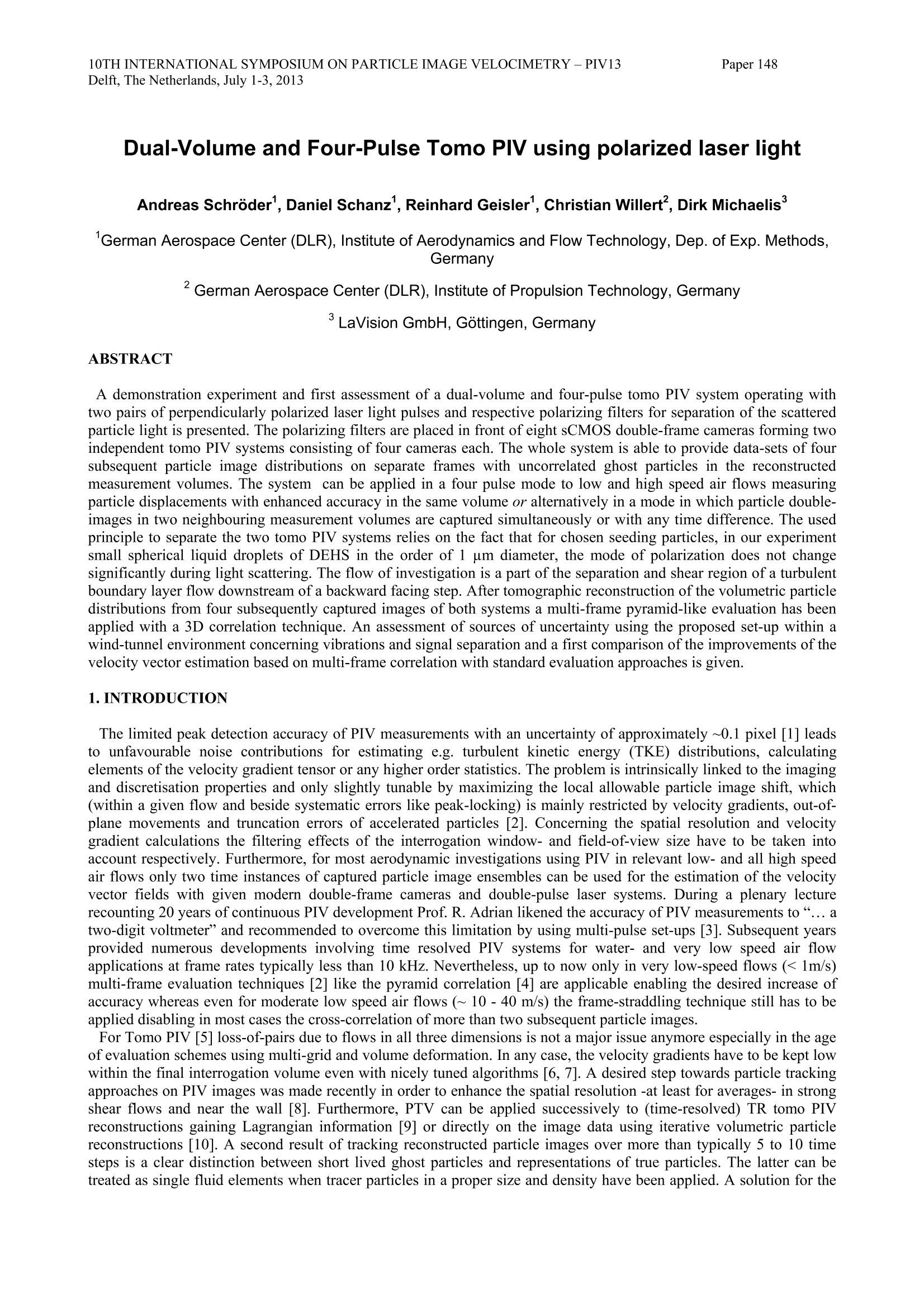
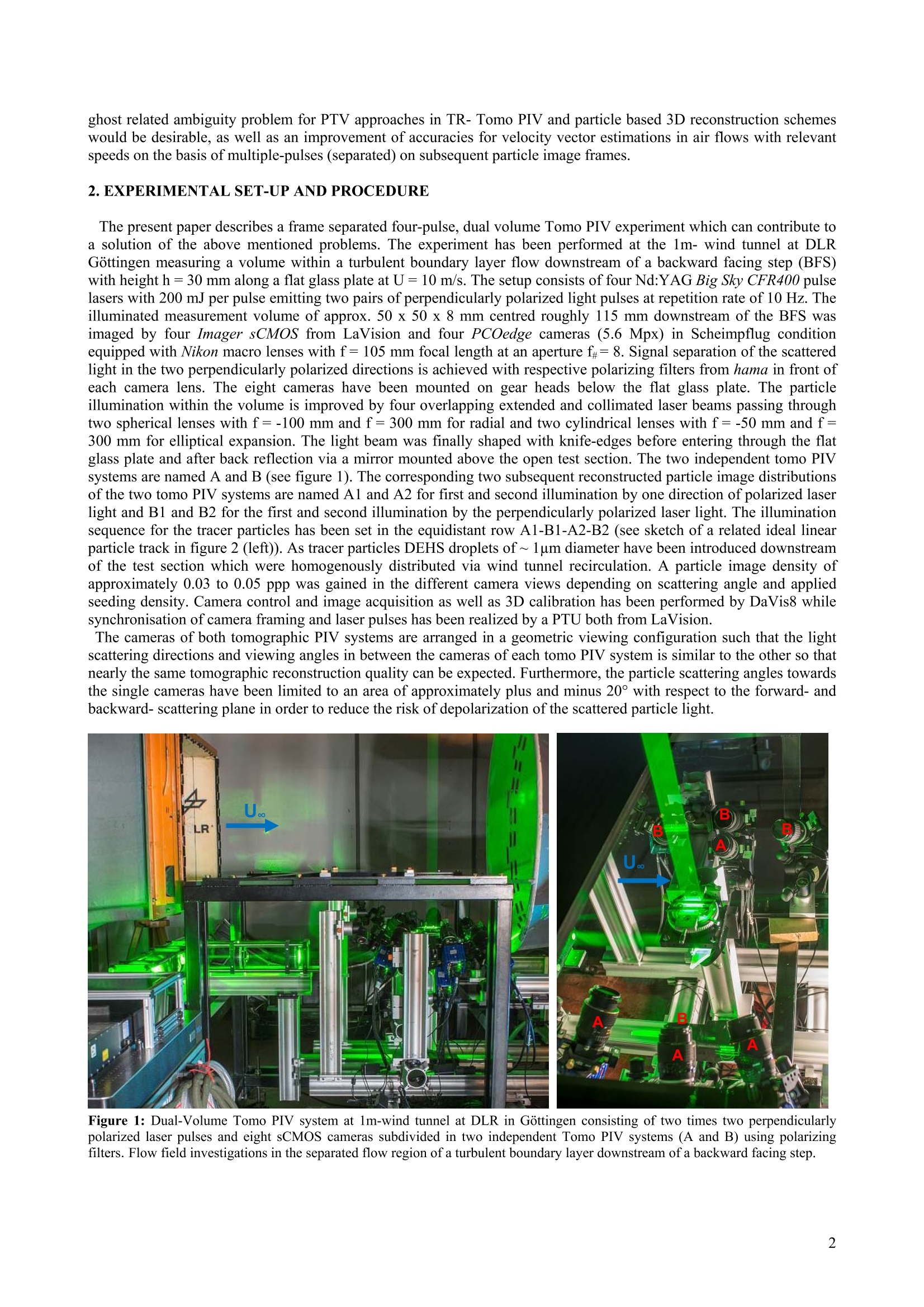
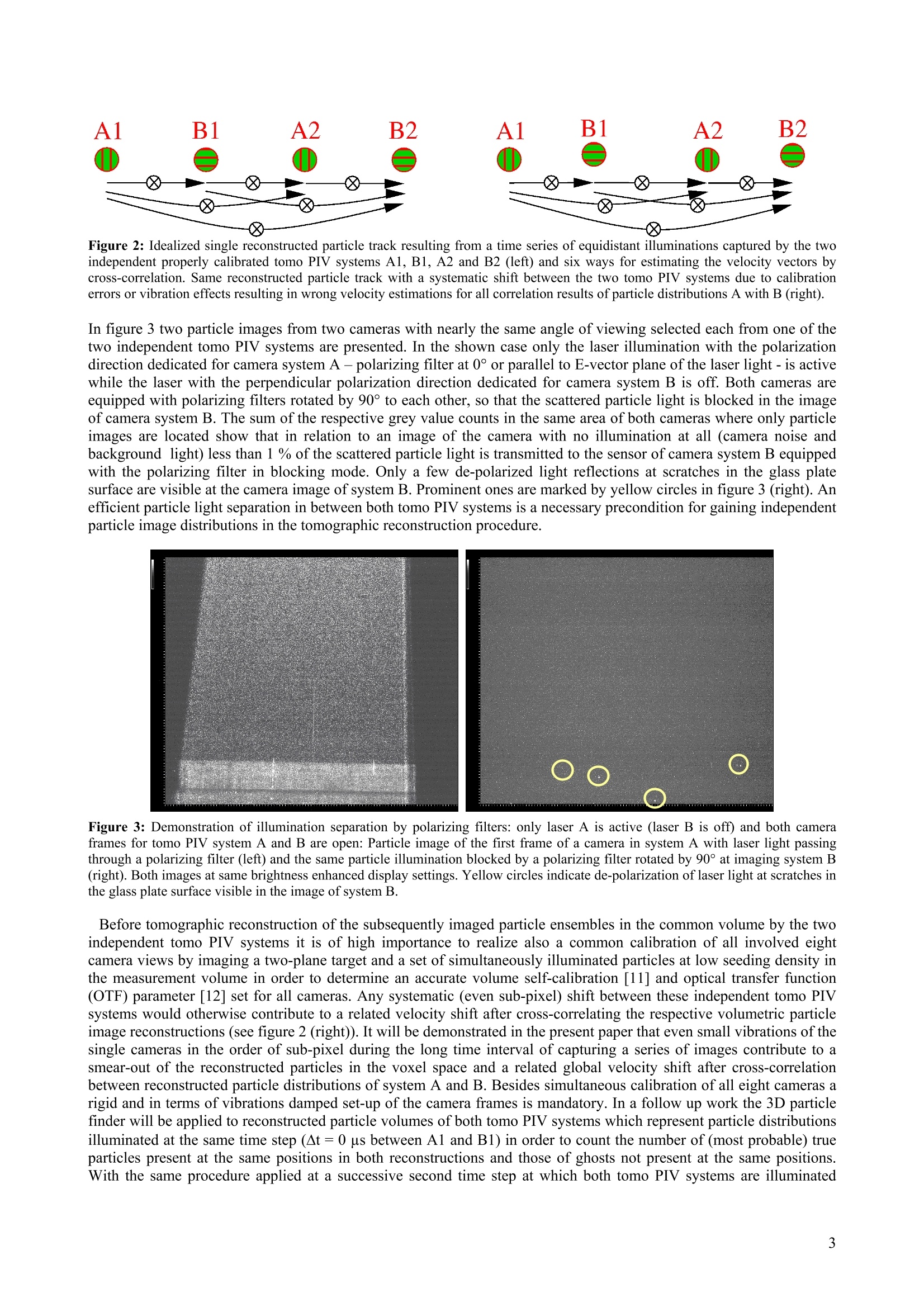

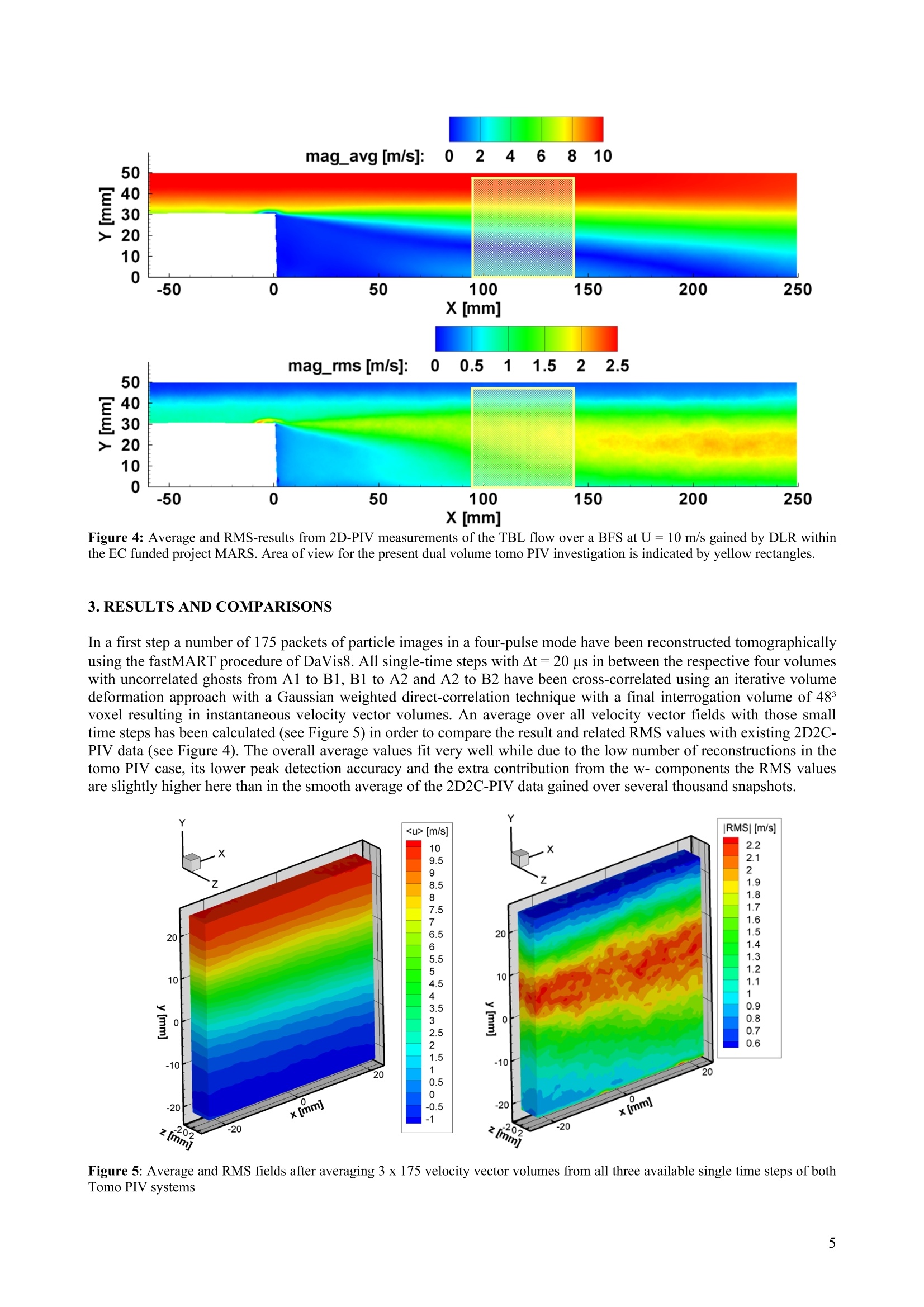
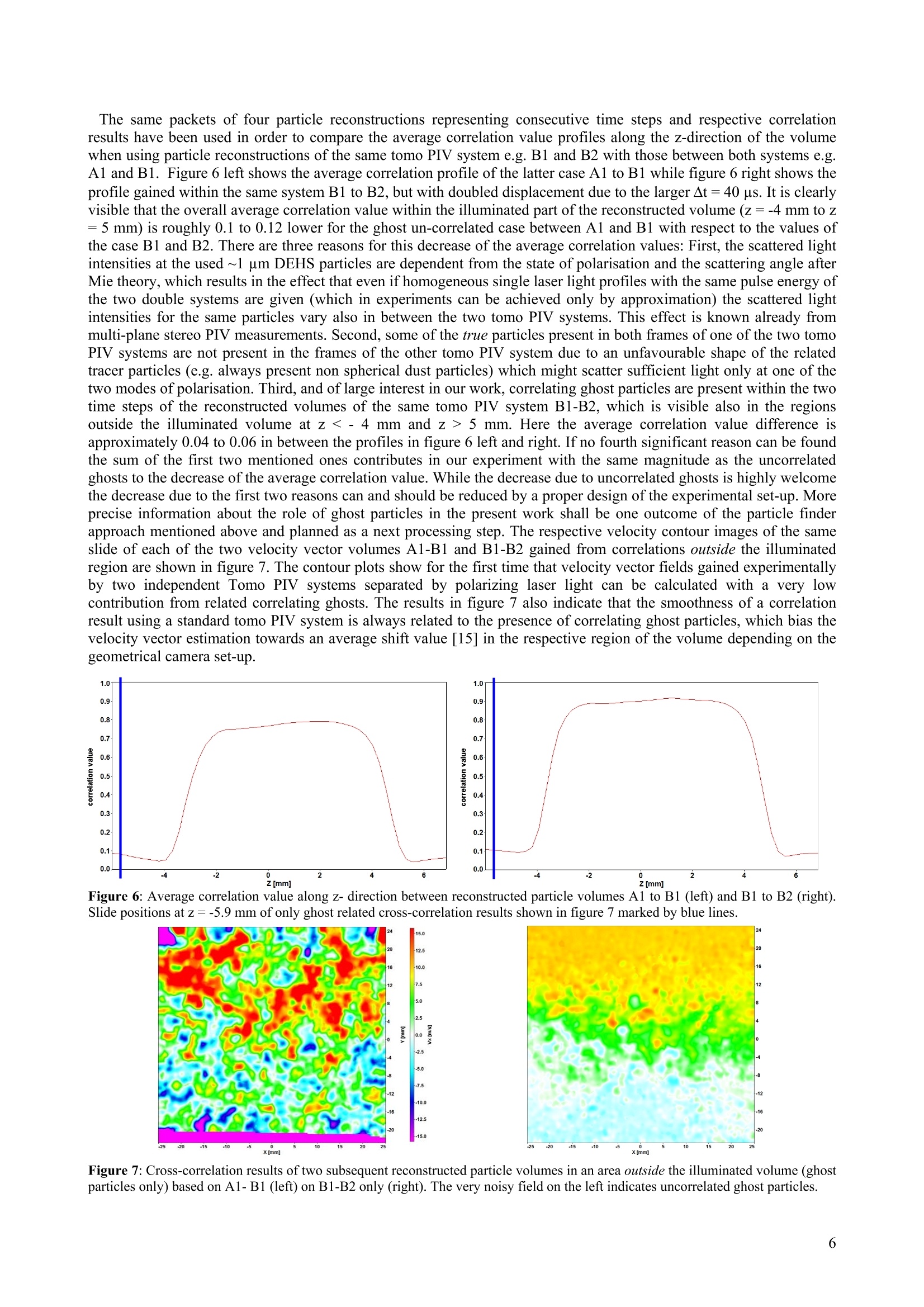
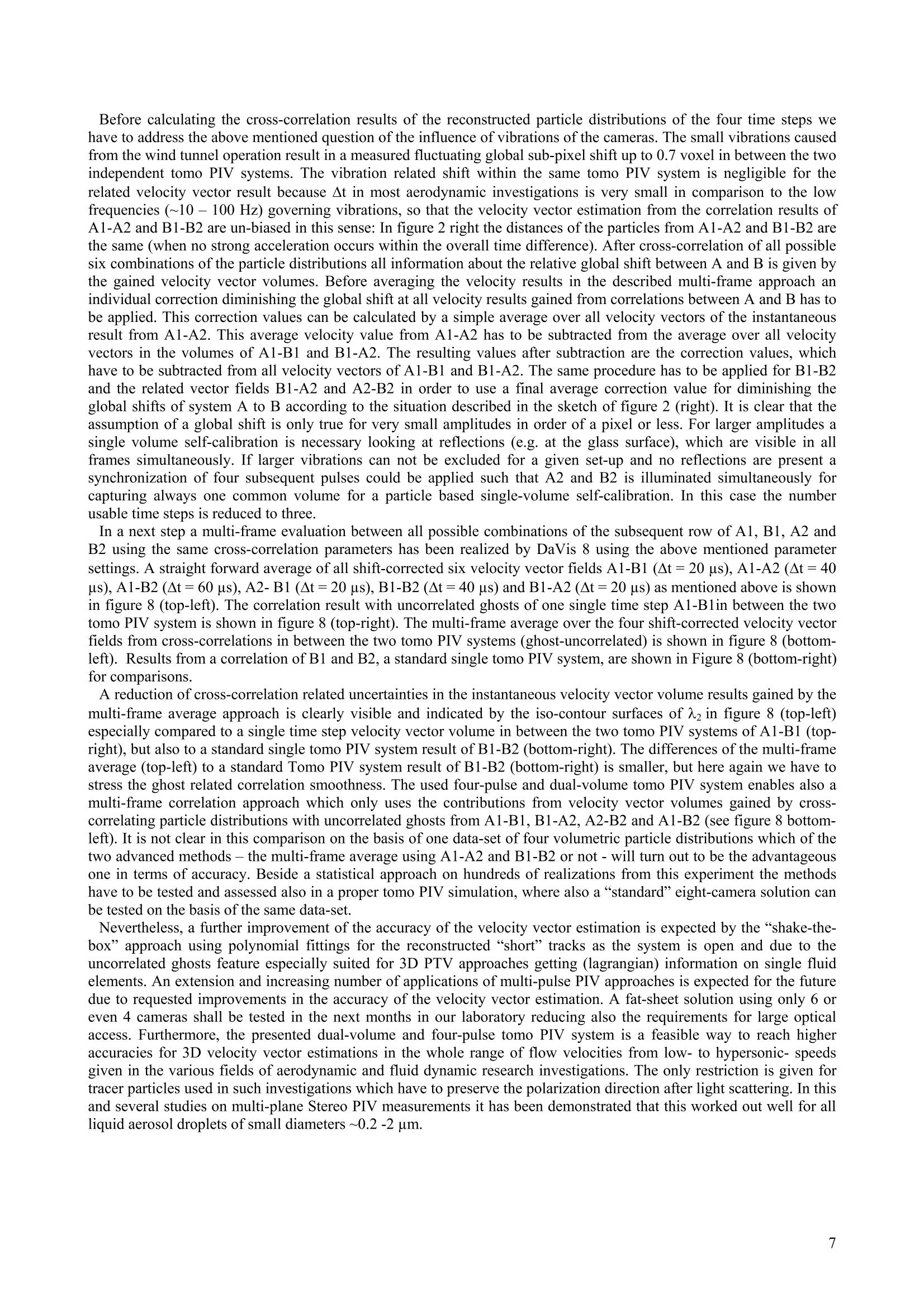
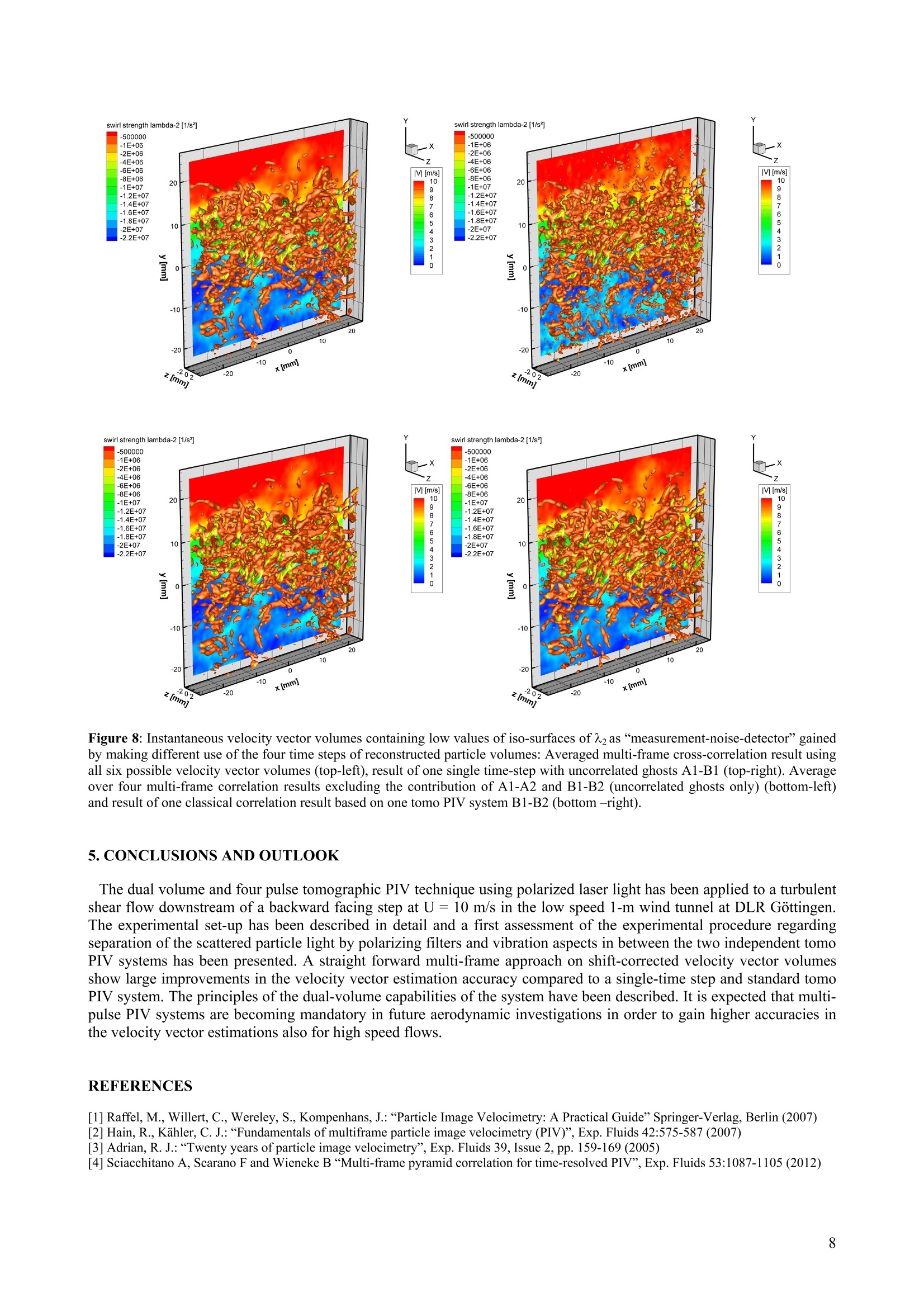

还剩7页未读,是否继续阅读?
北京欧兰科技发展有限公司为您提供《风洞中的空气流动中3D3C及4D3C速度矢量场检测方案(粒子图像测速)》,该方案主要用于其他中3D3C及4D3C速度矢量场检测,参考标准--,《风洞中的空气流动中3D3C及4D3C速度矢量场检测方案(粒子图像测速)》用到的仪器有体视层析粒子成像测速系统(Tomo-PIV)、LaVision DaVis 智能成像软件平台
推荐专场
相关方案
更多
该厂商其他方案
更多

















